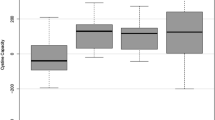Summary
Cysteamine bitartrate capsules (Cystagon) have been approved by the US Food and Drug Administration for use in patients with nephropathic cystinosis. Plasma cysteamine concentrations were virtually identical at various times following ingestion of either cysteamine hydrochloride or Cystagon capsules in 24 normal control subjects. A transfer study was done with eight cystinosis patients who had been receiving either cysteamine hydrochloride or phosphocysteamine for many years. The plasma cysteamine concentration was significantly higher 2h after Cystagon and the leukocyte cystine content was significantly lower at all times after Cystagon compared to older forms of the drug. These differences are probably the result of greater patient compliance in taking the capsules compared to the older, liquid forms of the drug. A new method for following the course of renal glomerular deterioration in diseases such as cystinosis has been published recently. This method was used to re-analyse data on the efficacy of cysteamine treatment and to re-analyse new data on treating cystinosis patients with either of two doses of cysteamine (1.30 g/m2 per day and 1.95 g/m2 per day). This new method agrees well with other methods and shows that both doses of drug are equally effective in maintaining glomerular function.
Similar content being viewed by others
References
Bickel H, Lutz P, Schmidt H (1973) The treatment of cystinosis with diet or drugs. In Schulman JD, ed.Cystinosis Washington, DC: US Dept of Health, Education, and Welfare, No. (NIH) 72–249, 199–224.
Clark KF, Franklin PS, Reisch JS, et al (1992) Effect of cysteamine-HCl and phosphocysteamine dosage on renal function and growth in children with nephropathic cystinosis.Clin Res 40: 113A (Abstract).
Clayton BE, Patrick AD (1961) Use of dimercaprol or pencillamine in the treatment of cystinosis.Lancet 2: 909.
Crawhall JC, Lietman PS, Schneider JA, Seegmiller JE (1968) Cystinosis. Plasma cystine and cysteine concentrations and the effect ofd-pencillamine and dietary treatment.Am J Med 44: 330–339.
Gahl WA, Reed GF, Thoene JG, et al (1987) Cysteamine therapy for children with nephropathic cystinosis.N Engl J Med 316: 971–977.
Gahl WA, Schneider JA, Schulman JD, Thoene JG, Reed GF (1990) Predicted reciprocal serum creatinine at age 10 years as a measure of renal function in children with nephropathic cystinosis treated with oral cysteamine.Pediatr Nephrol 4: 129–135.
Gahl WA, Schneider JA, Aula PP (1995) Lysosomal transport disorders: cystinosis and sialic acid storage disorders. In Scriver CR, Beaudet AL, Sly WS, Valle D, eds.The Metabolic and Molecular Basis of Inherited Disease, 7th edn. New York: McGraw-Hill, 3763–3798.
Goldman H, Scriver CR, Aaron K, Delvin E, Canlas Z (1971) Adolescent cystinosis: comparisons with infantile and adult forms.Pediatrics 47: 979–988.
Gretz N, Manz F, Augustin R et al (1983) Survival time in cystinosis. A collaborative study.Proc Eur Dialysis Transplant Assoc 19: 582–589.
Hambraeus L, Broberger O (1967) Pencillamine treatment of cystinosis.Acta Paediatr Scand 56: 243–248.
Hooft C, Carton D, De Schrijver F, Delbeke MJ, Samijn W, Kint J (1971) Juvenile cystinosis in two siblings. In Carson NAJ, Raine DN, eds.Inherited Disorders of Sulphur Metabolism. Edinburgh and London: Churchill Livingstone, 141–149.
Langman CB, Moore ES, Thoene JG, Schneider JA (1985) Renal failure in a sibship with late-onset cystinosis.J Pediatr 107: 755–756.
Manz F, Gretz N (1994) Progression of chronic renal failure in a historical group of patients with nephropathic cystinosis.Pediatr Nephrol 8: 466–471.
Markello TC, Bernardini IM, Gahl WA (1993) Improved renal function in children with cystinosis treated with cysteamine.N Engl J Med 328: 1157–1162.
Schneider JA (1994) Cysteamine for treatment of cystinosis. In Andreucci VE, Fine LG, eds.International Yearbook of Nephrology Dialysis Transplantation, 9th edn. Oxford: Oxford University Press, 97–102.
Schneider JA, Schlesselman JJ, Mendoza SA, et al (1979) Ineffectiveness of ascorbic acid therapy in nephropathic cystinosis.N Engl J Med 300: 756–759.
Smolin LA, Clark KF, Thoene JG, Gahl WA, Schneider JA (1988) A comparison of the effectiveness of cysteamine and phosphocysteamine in elevating plasma cysteamine concentration and decreasing leukocyte free cystine in nephropathic cystinosis.Pediatr Res 23: 616–20.
Thoene JG, Lemons R (1980) Cystine depletion of cystinotic tissues by phosphocysteamine (WR638).J Pediatr 96: 1043–1044.
Thoene JG, Oshima RG, Crawhall JC, Olson DL, Schneider JA (1976) Cystinosis. Intracellular cystine depletion by aminothiolsin vitro andin vivo.J Clin Invest 58: 180–189.
Author information
Authors and Affiliations
Rights and permissions
About this article
Cite this article
Schneider, J.A., Clark, K.F., Greene, A.A. et al. Recent advances in the treatment of cystinosis. J Inherit Metab Dis 18, 387–397 (1995). https://doi.org/10.1007/BF00710051
Issue Date:
DOI: https://doi.org/10.1007/BF00710051




